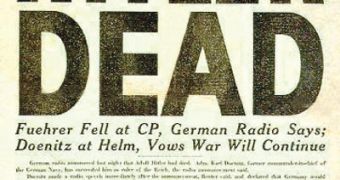Scientists in the United States have recently reported that the analysis of a bone fragment from a skull that is believed to have belonged to former Nazi Party ruler Adolf Hitler revealed that the remains actually belonged to a yet-unidentified woman. This is the same bone section that historians used to argue in their hypothesis that Hitler shot himself in his bunker, in the last days of World War II. Russian experts previously said that the bone fragment was found near Hitler's jawbone. The relic has been on display in Moscow's federal archive since 2000.
But the DNA analysis of the bone revealed that it belonged to a woman aged between 20 and 40, and not to a man in his late 50s, as Hitler was at the time of his death. The recent investigation was conducted by University of Connecticut archaeologist Nick Bellantoni, who traveled to the Russian capital city specifically to test the truth behind the Russian statements. He argues that he has experienced doubts that the fragment was, indeed, Hitler's, ever since he first saw it, according to the BBC News.
“The bone was very small and thin, and normally male bones are much more robust in our species. I thought it probably came from a woman or a younger man,” the expert says. The fragment is only a piece of a larger collection related to the former Nazi ruler that also includes a piece of blood-stained sofa material. It is widely believed that Adolf Hitler committed suicide in his bunker, along with his wife, Eva Braun, on April 30, 1945. Those in the bunker reported at the time that Hitler took a cyanide pill before shooting himself in the head.
However, the exact circumstances surrounding his death are far from clear. It's also known that the leader had at least one double, which he used when he felt his life was threatened. Over the years, the Russian KGB and NKVD (People's Commissariat for Internal Affairs) conducted numerous inquiries of their own, but without much success. A number of bones was found and burned, then dug up and moved to the Kremlin, the heart of the Soviet Union. Eventually, in 1970, KGB reports have it that the leader's bones (except the skull) were burnt, and the ashes thrown in the German Elbe river.

 14 DAY TRIAL //
14 DAY TRIAL //